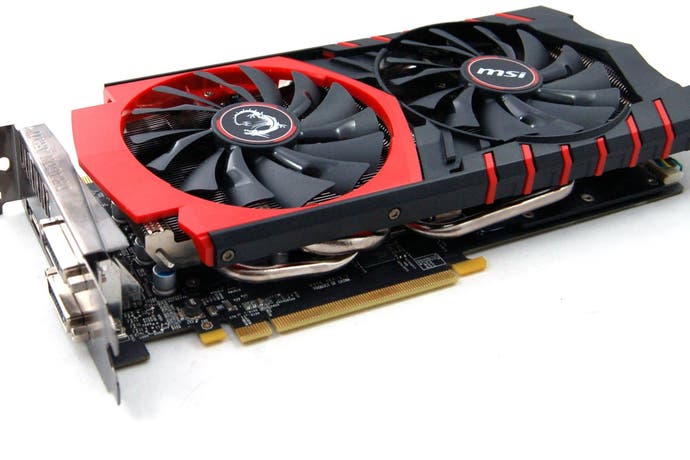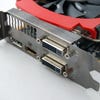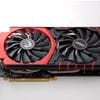Nvidia GeForce GTX 970 review
Meet the GPU that nukes almost the entire high-end graphics market from orbit.
UPDATE 23/2/15 9:40am: Nvidia's GeForce GTX 970 is currently the subject of much controversy owing to the firm marketing the card with incorrect specs - a state of affairs that has led to a lawsuit. For a deep-dive explanation of the issue, we recommend this article. We are re-evaluating the GTX 970, but our current findings suggest that at 1080p and 1440p this remains an exceptional product. You can find more recent testing of the GTX 970 across a wider range of more modern games in our graphics card upgrade guide.
The GeForce GTX 970 is that rarest of things in the graphics card market - a genuine game-changer. In fact, it's actually more like a cooked hand grenade strategically lobbed into the high-end GPU market, designed to cause maximum damage to the competition - but in the process impacting just as many Nvidia cards too. It costs £260, which is a lot of money, but its performance per pound ratio is so strong that some might say there's little point considering any other high-end GPU currently available - and that includes Nvidia's own flagship GTX 980.
The headlines are this: AMD's R9 290 and top-line R9 290X - £300 and £400 GPUs respectively - are effectively obsolete: hot, power-hungry, inefficient products that are effortlessly bested by Nvidia's £260 upstart. Nvidia is caught in the blast radius itself too - the GTX 780 is history, while the 780 Ti - a card that sold for over £500 just a few months - is also bordering on the irrelevant. Overclocked, the GTX 970 also beats the stock performance of the £430 GTX 980 in most applications too - a phenomenal showing bearing in mind that the latter is 65 per cent more expensive.
The fallout doesn't end there though, as there are the ramifications for the dual-GPU market too. AMD's beautifully insane, water-cooled 11.5 teraflop Radeon R9 295X2 - the product that humbled Nvidia's $3000 Titan-Z folly - was pretty much the only contender for high quality, high frame-rate 4K gaming until the arrival of Maxwell. With the way things stand now, two 970s in SLI will be cheaper, cooler, quieter and far more power-efficient. It's something we'll look into testing, but based on the results on this page, an SLI 970 set-up should almost certainly prove more capable too in most titles.
We would have loved to review the GTX 970 in concert with its bigger brother last week, but curiously Nvidia decided not to sample it to reviewers, instead leaving it to third party board-makers to supply the press. MSI came to the rescue in our case, providing us with its new card based on its TwinFrozr 5 design, impressing us with its ability to stay whisper-quiet even when we over-volted and overclocked this card to its limits. The three DisplayPort outputs of the reference card are dispensed with in favour of the traditional dual-DVI/HDMI/DisplayPort arrangement, while curiously the six-pin/six-pin power inputs are replaced with an eight-pin/six-pin set-up. MSI's custom cooler has always impressed - the R9 290 we used for CrossFire testing in our R9 295X2 piece was also a peach.
- Order the GTX 970 4GB from Amazon with free shipping
We kick off with our standard gameplay initiation test for high-end GPUs - a maxed-out Crysis 3 in the demanding Welcome to the Jungle stage, operating at 1080p. According to the Steam hardware survey, 95 per cent of PC gamers use this resolution, and we'd be willing to bet that the vast majority of those screens operate at 60Hz. Our aim in the Crysis 3 test is to do our best to match GPU power and in-game settings in order to target a 1080p60 gameplay experience - the best possible match for this most ubiquitous of displays.
As we have a big bunch of existing data sitting on our hard drive from our recent GPU testing, we actually have two comparisons for you here. In the first case, the GTX 970 faces off against its AMD competition - the Radeon R9 290 and the more expensive version of the Hawaii technology, the R9 290X. And after that, the challenge is repeated with a brace of Nvidia challengers - the GTX 780 Ti and the top-end GTX 980.
The end result is that it is the £430 GTX 980 that provides the best 60fps lock, while the Radeon R9 290 has the most trouble maintaining the desired performance level. In the middle sits the GTX 780 Ti, the R9 290X and the GTX 970. The new Nvidia card appears to inch ahead of both. Frame-rates dip, of course, but to a lesser degree than the 780 Ti and 290X - this is a remarkable state of affairs bearing in mind that until last week these were the two best single-chip GPUs money could buy.
Alternative analysis:
Crysis 3 gameplay: GTX 970 vs GTX 780 ti vs GTX 980
Order our comparison graphics cards with free shipping:
- Radeon R9 290 4GB
- Radeon R9 290X 4GB
- GeForce GTX 780 Ti 3GB
- GeForce GTX 780 3GB
- GeForce GTX 980 4GBGB
So with a practical example of the GTX 970's power in the bag, let's look at the theoretical, by running the new card through our range of benchmarks in both stock and overclocked states. Using MSI Afterburner, we push the power envelope up to 110 per cent. In this scenario, we can push core clock up a further 185MHz, while the 4GB of onboard GDDR5 is rock-solid at 8000MHz - a welcome 14 per cent boost to memory bandwidth. We upped the maximum fan-speed to 70 per cent to accommodate the increase in heat output, but the card was still very, very quiet overall - a feather in the cap for MSI's new TwinFrozr design.
The results at our first (and arguably most important) test resolution - 1080p - demonstrate that this is a potent piece of hardware. The GTX 970 offers broadly equivalent performance to the 780 Ti on Crysis 3 and Battlefield 4, while it is highly unlikely that many would notice any difference at all in terms of BioShock Infinite or Metro Last Light performance. In our GTX 980 testing we found that the card was a little weak on Crystal Dynamics' Tomb Raider - and that appears to carry across to the 970 too. It's the only benchmark where the R9 290X beats Nvidia's upstart, while the R9 290 isn't really at the races at all.
Of course, the really eye-opening comparison is between the overclocked GTX 970 and the stock GTX 980. We've essentially clawed back all of the performance (even moving slightly ahead in some cases) in all of our test titles, with just Crysis 3 falling a little short. However, in all cases, the GTX 780 Ti is left behind by an overclocked 970. In our tests, GPU throughput is increased by 10 to 15 per cent via overclocking, depending on the application.
| 1920x1080 (1080p) | GTX 970 | GTX 970 (OC) | GTX 980 | GTX 780 Ti | R9 290X | R9 290 | GTX 780 |
|---|---|---|---|---|---|---|---|
| BioShock Infinite, DX11 Ultra DDOF | 111.1 | 122.8 | 121.6 | 116.5 | 93.0 | 87.9 | 99.5 |
| Tomb Raider, Ultimate, FXAA | 81.6 | 94.3 | 91.1 | 90.9 | 85.1 | 75.0 | 71.3 |
| Battlefield 4, Ultra | 77.3 | 87.5 | 87.2 | 78.0 | 70.1 | 63.5 | 65.2 |
| Metro: Last Light, Very High, SSAA | 47.7 | 54.4 | 52.0 | 51.0 | 47.4 | 42.7 | 40.9 |
| Crysis 3, Very High | 70.5 | 79.0 | 86.7 | 71.9 | 68.6 | 63.3 | 60.9 |
For those looking for a 'better than console' experience for their powerful PCs, a good route forward is to acquire a 2.5K display, operating at a 2560x1440 resolution. Most PC gaming occurs on the desktop, with the player sitting very close to the display. In these conditions, the 77 per cent increase in pixel-count over standard 1080p produces outstanding results.
Of course, servicing that large increase in pixel-count requires a meaty graphics card - and perhaps a reduction in quality settings in-game. We re-run our 1080p tests at the higher resolution and find that the GTX 970 still manages to deliver the goods. The R9 290 and GTX 780 are left behind on all tests (bar the perennial thorn in the side, Tomb Raider) while at stock speeds, the card battles it out with the R9 290X and GTX 780 Ti.
Once again we see that overclocking the GTX 970 eliminates the deficits for the most part, allowing it to compete directly with its bigger brother. Usually we're not entirely keen on overclocking - there's a sense of diminishing returns on performance in combination with an awfully large increase in heat and power draw. The Maxwell architecture scales nicely though and energy consumption and heat levels are still lower than all of the last-gen cards.
| 2560x1440 (1440p) | GTX 970 | GTX 970 (OC) | GTX 980 | GTX 780 Ti | R9 290X | R9 290 | GTX 780 |
|---|---|---|---|---|---|---|---|
| BioShock Infinite, DX11 Ultra DDOF | 74.0 | 84.2 | 83.3 | 77.2 | 61.7 | 58.4 | 65.4 |
| Tomb Raider, Ultimate, FXAA | 54.4 | 62.4 | 60.9 | 62.2 | 58.5 | 51.5 | 49.0 |
| Battlefield 4, Ultra | 50.5 | 57.2 | 58.0 | 52.0 | 47.3 | 43.3 | 44.2 |
| Metro: Last Light, Very High, SSAA | 29.9 | 34.4 | 32.6 | 32.2 | 29.7 | 27.2 | 25.8 |
| Crysis 3, Very High | 43.1 | 49.4 | 47.8 | 45.0 | 45.1 | 41.1 | 37.4 |
Both AMD and Nvidia have made plenty of noise about 4K gaming in the last 18 months. There was a time when 1080p was not considered a true PC gaming resolution, but that quickly changed owing to the establishment of the full HD standard and its proliferation in living rooms. 4K is the next step, ultra-HD gaming displays are becoming more numerous and cheaper - and the GPU vendors like to consider that their products are future-proof. The good news is that the Maxwell cards - GTX 980 and 970 - both feature HDMI 2.0 outputs, meaning that these GPUs can output 4K at 60fps - doubling the capabilities of the existing HDMI 1.4 standard. But do they have the horsepower to produce a compelling gameplay experience?
In this final series of benchmarks, we apply a little realism. Ultra-level settings aren't designed with 4K in mind, and rendering features like insane anti-aliasing aren't really needed when the size of pixels on a 4K display is so very small. So in these tests, we typically drop down from ultra settings to the next level down, and cut out multi-sampling or super-sampling anti-aliasing altogether.
The results demonstrate that you're still looking for a dual GPU solution for anything approaching 60fps gaming - some might consider the combination of combination of circa 30fps frame-rates with pared back settings too much of a compromise. The GTX 980 dominates for the most part here, but the sheer effort required by the GPUs in producing a single frame sees the delta between the cards close considerably. The GTX 970 at stock isn't the best performer by a long short, but the overclock clearly makes it more competitive with the more expensive cards.
| 3840x2160 (4K) | GTX 970 | GTX 970 (OC) | GTX 980 | GTX 780 Ti | R9 290X | R9 290 | GTX 780 |
|---|---|---|---|---|---|---|---|
| BioShock Infinite, DX11 Ultra | 50.3 | 58.2 | 57.4 | 50.7 | 43.7 | 40.6 | 39.9 |
| Tomb Raider, Ultra, FXAA | 35.1 | 40.5 | 39.5 | 43.3 | 40.1 | 37.1 | 34.1 |
| Battlefield 4, High | 40.9 | 46.8 | 46.2 | 41.9 | 38.9 | 36.7 | 35.8 |
| Metro: Last Light, High, AAA | 32.8 | 37.7 | 36.4 | 33.1 | 30.4 | 28.6 | 27.6 |
| Crysis 3, High | 32.0 | 37.2 | 34.2 | 33.4 | 35.2 | 32.8 | 28.1 |
We round off our metrics with a look at power consumption - an area where Maxwell rules with an iron fist. What's interesting to note is that all the various cutbacks made to the Maxwell chip found in the GTX 970 do not actually result in any increase in power efficiency. Peak energy consumption on the two new Nvidia cards is watt-for-watt identical in both stock and overclock scenarios.
It's the tiniest of disappointments bearing in mind the big performance wins offered by the GTX 970 in general, though - not to mention the fact that overall efficiency still outstrips the Hawaii chip in the R9 290 and 290X, and indeed the GK110 processor found in GTX 780, Titan and 780 Ti, even with an aggressive overclock in place.
To put the figures into context, we should stress that this is complete system load measured at the wall with a watt meter. Our test set-up for this article is a Core i7 3770K running at 4.3GHz (with no additional voltage required) in combination with 16GB of DDR3 RAM.
| GTX 970 | GTX 970 (OC) | GTX 980 | GTX 980 (OC) | GTX 780 Ti | R9 290X | GTX 780 | |
|---|---|---|---|---|---|---|---|
| Peak System Power Draw | 265W | 301W | 265W | 301W | 345W | 363W | 312W |
We also looked into Dynamic Super Resolution (DSR) a little more closely. This is the Maxwell-specific technology that allows users to access much higher rendering resolutions for their games, with the GPU downscaling on the fly to the native pixel-count of the display. At Nvidia's recent tech conference, the firm was confident that there would be no hit to performance - despite the downscaling algorithm using a 13-tap Gaussian filter to improve results compared to basic super-sampling.
We benched a number of titles both at native 4K, and at 1080p with a 4K DSR downscale. In all cases frame-rates on the DSR tests were lower - but only in the region of one to two per cent. These results fall into the margin of error, and they're certainly not noticeable during gameplay. DSR is a fascinating technology, but on the vast majority of modern titles, you are going to need a hell of a lot of horsepower to use it.
As anti-aliasing goes, you're never going to beat the brute-force approach of rendering at a much higher resolution and downscaling - as the DSR examples we previously ran, repeated below, should demonstrate.
















Nvidia GeForce GTX 970 - the Digital Foundry verdict
It takes something really special to truly stand out in the graphics card market these days. Typically, AMD and Nvidia price their products according to the horsepower available, leading to a market where cost is firmly linked to performance, with only the top-end (often unattainable) parts bucking the trend, usually providing even less overall value in terms of performance per pound/dollar.
The GTX 970 is different. It doesn't quite hit the enthusiast gamer pricing sweet spot, but it offers so much raw performance that the additional premium makes it seem like a no-brainer. This is a £260 product that can beat cards that were retailing for almost double the price just a few months ago. Put simply, it's a radical shake-up of price vs performance in the gaming graphics space, and a remarkable product from a company that more usually adopts a premium pricing strategy for its top-end wares.
What's clear is that Nvidia no longer wants to make graphics cards based on its large, expensive GK110 chip - Titan, GTX 780 and 780 Ti are all targeted for termination with the release of GTX 970, which is smaller, cooler, more efficient - and crucially for Nvidia, cheaper to make. This process of clearing out the range has had an unfortunate effect on AMD's premium products - both the R9 290 and the 290X now look far too expensive and will need to be heavily discounted in order to remain competitive. Nvidia's own lower-end products are subject to price cuts as we speak and there are enticing prices on the GTX 770 and GTX 760 (780 and 780 Ti are also cut, but the GTX 970 still makes them look a little dear in our opinion). There's no sub-£200 enthusiast Maxwell yet (Update: aside from the budget GTX 750 Ti), but the arrival of the GTX 970 ensures that - indirectly - there are some nice bargains further down the stack too.
In summary, in our review of the GTX 980 flagship, we loved the new Maxwell chip's power efficiency, but there was no seismic shift upwards in top-end performance: Nvidia made a smaller, smarter processor that only offered marginal gains over the GTX 780 Ti. What we had was a great tech story, but not exactly an all-out enthusiast pleaser. What's clear now is that if we were looking for a radical, game-changing product, we were looking in the wrong place. The GTX 970 more than fits the bill: it brings the ultra high-end GPU experience that much closer to the mainstream to the point where the value offered here is almost ridiculous. As such, Nvidia's latest comes recommended without reservation.
Nvidia debuted its new technology at a recent conference in the USA, which we attended. Nvidia paid for travel and accommodation. However, the GTX 970 and the other graphics cards featured in this piece were tested at the Digital Foundry office.









